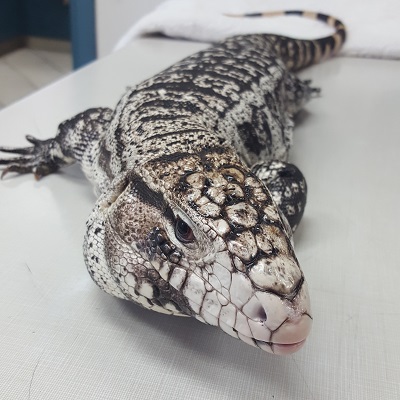
We are bidding the tegu a fond farewell as our Animal of the Month now that August is winding down. There are three species of tegus that we see at our clinic, but the Argentine black and white tegu is our most common tegu patient so we focused on this species for our feature. We hope you were following us on Twitter @ExoticPetVets as we tweeted about these intelligent and affectionate reptiles during the month. Here is a summary if you missed any of our tweets. Did you know?:
- The Argentine black and white tegu’s previous scientific name was Tupinambis merianae, but in 2012 this species (along with other tegu species) was reclassified as Salvator merianae after further research on the species.
- Their name betrays from where Argentine black and white tegus originate – South America, of course. They can be found in Argentina, Uruguay, Brazil, Paraguay and Bolivia.
- In the wild, Argentine black and white tegus are normally found in grassy forest-edge savanna habitats.
- Argentine black and white tegus are very adaptable and they can – and do – live successfully in a wide variety of environments, including forests and areas disturbed by humans; such as land cleared for agriculture or roads.
- Argentine black and white tegus are omnivores, meaning they eat both plant and animal matter. And they aren’t picky eaters – they will eat just about anything they find.
- Because Argentine black and white tegus are so adaptable with their diet and environment, they have become a big problem in Florida, where there are feral tegu populations that have originated from escaped or released pets.
- Feral Argentine black and white tegu populations in Florida have been found in the state’s ecologically sensitive everglades and are known to raid the ground nests of native sea turtles, alligators and birds so they can eat the eggs.
- Argentine black and white tegus are the largest of the tegu species. Adult females grow to about 3 feet (just under 1 metre) in length, while males are more muscular and can grow to about 4 feet (1.2 metres) in length.
- Argentine black and white tegus have beaded skin, for which they are hunted by humans. They have short necks and legs. They also have forked tongues.
- As their name suggests, adult Argentine black and white tegus have black and white patterned skin. When they’re young, their skin is black and green. Over a few months, the green markings gradually become white as the tegu ages.
- Like all tegus, the Argentine black and white tegu walks on four legs. But did you know that tegus can run for short distances on two legs?
- The Argentine black and white tegu, along with other tegu species, will run on two legs (bipedally) often as a way to defend their territory. They will also run with their mouths open to appear more menacing.
- Like all tegus, Argentine black and white tegus are considered to be among the most intelligent of reptiles. They are also very loving.
- In captivity, Argentine black and white tegus recognize their non-tegu family members and form close bonds with them. Some tegus can even respond when they hear their names being called!
- You may have heard of Winston the tegu, who is an Argentine black and white tegu. Winston was dumped in a box in front of a Michigan zoo. Winston was eventually adopted and now has a forever home with a loving family.
- Winston the tegu is also an Internet star and has a variety of social media accounts, including his own YouTube channel!
- Argentine black and white tegus can live on average between 15-20 years both in the wild and in captivity with proper care.

